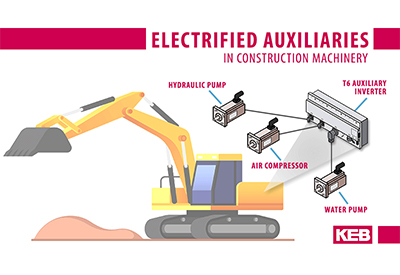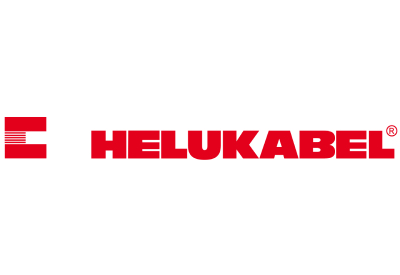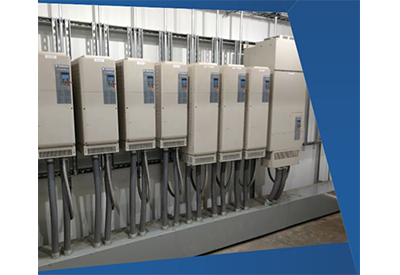Electrifying Construction Equipment – the Role of Auxiliary Inverters

March 16, 2020
Every year there are more and more types of vehicle applications moving towards electric. The benefits are clearly unquestionable: reduced emissions, lower noise, less maintenance, and increased performance. But, most all-electric construction equipment offerings to-date have largely been confined to mini-excavators and small wheel loaders while only a few manufacturers have unveiled full-scale heavy equipment prototypes. Naturally, there is large power gap to fill before electrifying construction equipment overtakes the main powertrain. So, what can the industry expect?
Well, expect it to be a process. Going forward, possible needs include decreased battery size and weight, extended operating times, and reduced charging times. It will take time for technology to progress far enough to fully meet the needs for all-electric heavy construction equipment. In the meantime, the electrification process will be incremental. Even if the powertrain remains a combustion engine, there is the opportunity to electrify the auxiliary pumps, compressors, and fans with electric motors and inverters as part of a hybrid design. By taking advantage of the current technological capabilities, the benefits of electrification can be realized today.
Benefits of Auxiliary Electrification
Auxiliaries can be described as all the extra loads on a vehicle which do not contribute to traction power. These include hydraulic pumps, power steering pumps, water pumps, air compressors, A/C compressors, and radiator fans. On a combustion vehicle the engine drives these auxiliaries. On the other hand, hybrid topologies retain the combustion engine and the auxiliaries are electrified, de-coupling them from the motor and unlocking the following benefits.
Increased efficiency – Engine-driven auxiliaries are parasitic loads requiring the engine to work harder or run at a less-than-optimal operating point. Instead, electrifying the auxiliaries can reduce the size of the engine needed and de-coupling the auxiliaries allows the engine to run at a more fuel-efficient operating point. An ideal example would be the hydraulic pumps on wheel loaders. But, even if these must remain combustion driven due to large power requirements there is still the opportunity to shed other loads such as the steering pump, coolant circulation pump, and radiator fan.
Increased performance – In some instances, the needs of an auxiliary are at odds with the engine’s operation. For example, a wheel loader’s engine rpm may drop while driving into a pile at low speed, which is in contrast to a higher engine speed needed for the hydraulic pump to lift bucket. On the other hand, utilizing an electrically-driven hydraulic pump would have the pressure primed and ready. Since electrified auxiliaries are de-coupled from the engine, they operate independently with “power-on-demand” for increased performance and reliability. This ensures equipment operates how you want it, when you want it.
Eliminate idling noise – In some applications, the auxiliaries equipment may be largely stationary, yet the engine continues to idle while not in use. This results in unwanted noise and unnecessary emissions. Examples of this would be excavators or various types cranes. Some of these applications may require constant duty or have very large hydraulic systems which may not make electrification feasible. But, there could very well be opportunity for electrification on intermittent-use equipment or applications which can also charge the battery with regenerated energy from overhauling loads.
Selecting an Auxiliary Inverter
Space, weight, and the ability to meet operating condition requirements are usually the top criteria by vehicle and equipment designers for auxiliary inverter selection. With these requirements in mind, below are further considerations to help guide the selection of an auxiliary inverter appropriate for the application.
Rugged Design = Made to handle construction equipment demands – An industrial inverter in an enclosure simple won’t do. Rather, an inverter with automotive-qualified components and tested for shock and vibration (in accordance with ISO 16750-3 Code L) and appropriate temperate ranges is needed to withstand operating environment of construction equipment. Furthermore, an IP67 or IP6k9k environmental protection rating allows flexible mounting options, including chassis mounting and exposure to the elements. Lastly, a liquid-cooled unit will reduce weight and space requirements.
All-in-One Design = Saving space and reducing weight – An all-in-one inverter is a “system” design that combines multiple inverters into a single housing compared to using individual inverters for each auxiliary. The compact design reduces cabling and eliminates redundant components to minimize space and weight while also providing a simplified system layout.
Scalable and Modular Design = Flexibility – An inverter system with the ability to scale by adding inverter outputs based on the number of auxiliaries needed and modular power options for each output to match an auxiliary’s power rating provide the vehicle designer a fully flexible system for a variety of different applications. Furthermore, a uniform programming environment supporting multiple motor types enables the developer to easily integrate a wide array and mix of auxiliaries from multiple vendors on a familiar platform.
Given the large number of potential construction equipment applications, the KEB T6 Auxiliary Inverter is a highly flexible solution. The “all-in-one” system can be scaled from 1 – 6 independent motor controllers with modular power options of 7.5 kW, 15 kW, or 30 kW for each output and supports all types of AC motors, including induction, permanent magnet, and switched reluctance motors.
The T6 is specifically designed for commercial and off-highway vehicle applications and is made with automotive-qualified components to meet automotive environmental temperature, shock and vibration standards to withstand the rigor of commercial off-highway vehicles and equipment. As construction equipment continues to incorporate more electrified auxiliaries towards the path of all-electric offerings, the KEB T6 Auxiliary Inverter provides a flexible and durable solution for a variety of applications in addition to electrifying construction equipment.







